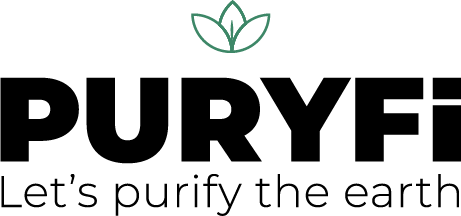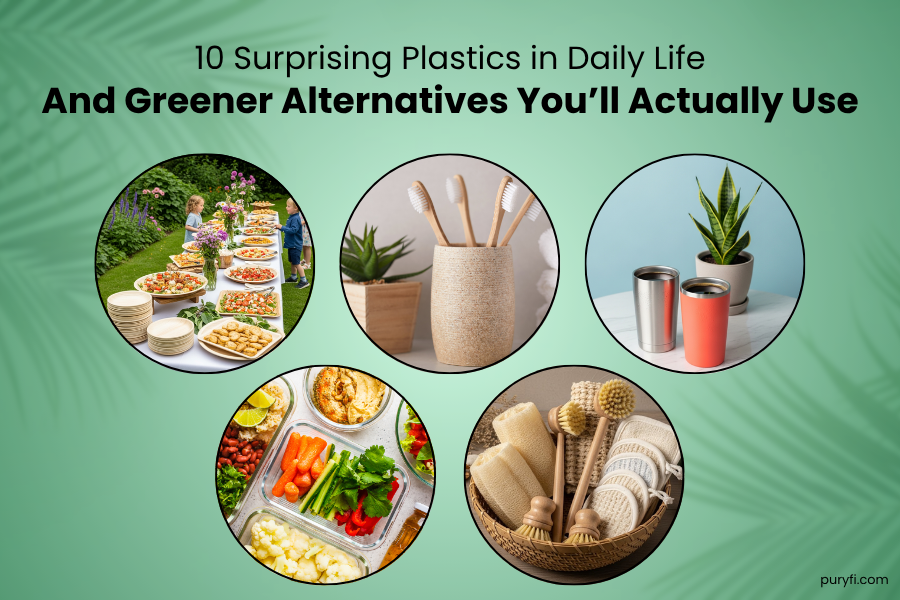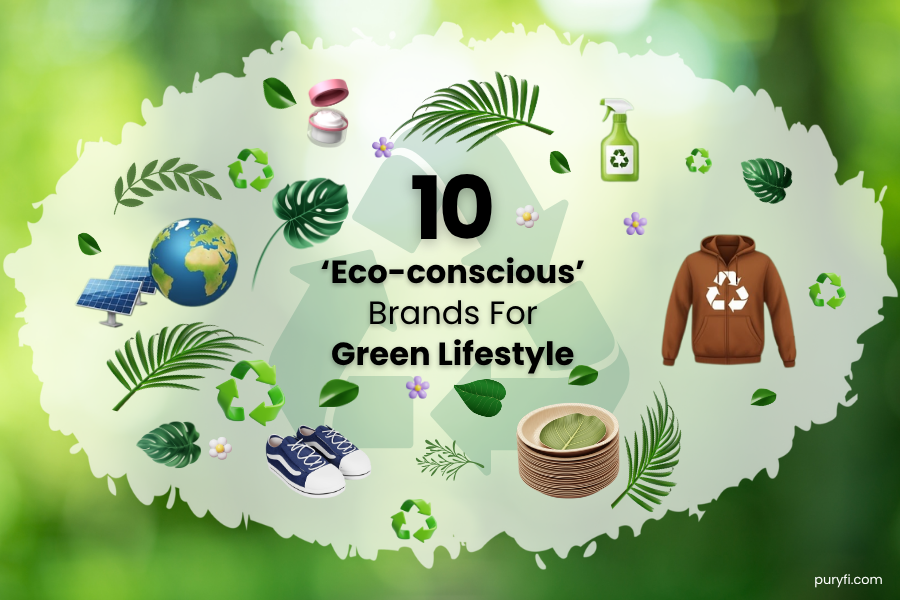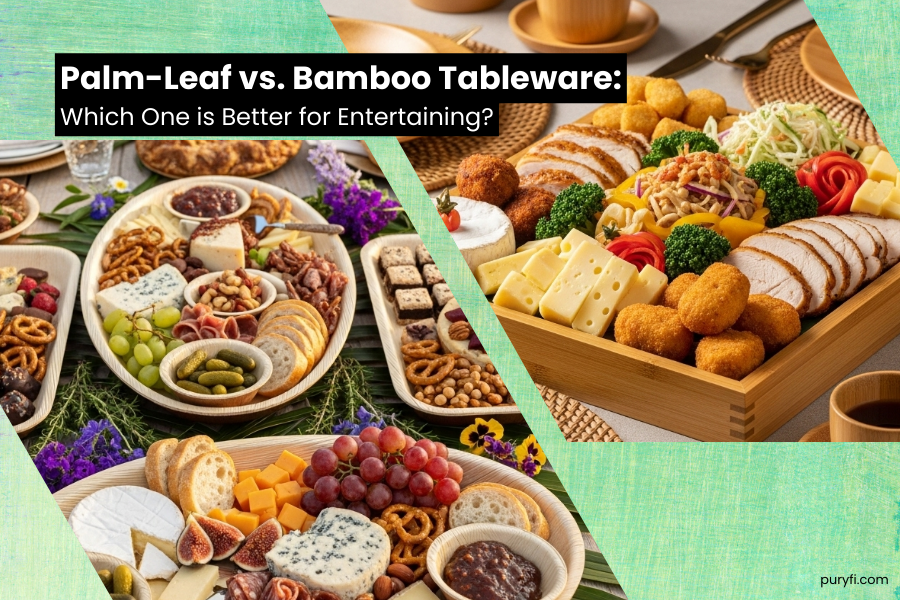Plastic-Free Lifestyle? It’s Easier Than You Think
You’re committed to a plastic-free lifestyle. You carry your own tote bag to the market, sip from stainless steel bottles, and don’t hesitate to say “no straw, thanks.” But here’s the thing: plastic is still sneaking in, in unexpected places, quietly contributing to waste.
When was the last time you thought about tea bags? Grocery receipts? Or even stickers on fruit?
These sneaky habits blur the line between convenience and conscious living. But once you notice them, the path to a zero waste lifestyle becomes clearer and more achievable.
This post helps you spot 10 surprising places plastic hides in everyday life, why it matters, and how plastic-free swaps can help you live more sustainably, without adding friction.
1. Disposable Plates & Cutlery at Gatherings

Where It’s Hidden
At birthday parties, family gatherings, or quick BBQs, disposable plates and utensils are often plastic or plastic-coated, blending convenience with hidden environmental and health costs.
Why It Matters
“Biodegradable” disposables often need industrial composting, which is rarely accessible. They languish in landfills, fragmenting into microplastics that persist for centuries. These tiny particles pollute water sources and food chains, undermining efforts toward a plastic‑free lifestyle.
Effects on the Body
When heated or used with hot food, plastic utensils can release chemicals like bisphenol A (BPA). It is a known endocrine disruptor that mimics estrogen and is linked to reproductive issues, metabolic disorders, and hormone imbalances . Over time, BPA and other plastic additives may accumulate in tissues, potentially altering developmental health and increasing risks of diabetes and cardiovascular disease .
Greener Alternative
Choose palm-leaf tableware, crafted from fallen leaves without chemicals. It’s fully compostable in around 60 days, beautifully designed, and eliminates cleanup. Palm-leaf plates offer a stylish, practical, and truly planet-friendly alternative to disposable plastic, supporting a zero-waste lifestyle effortlessly.
2. Tea Bags with Plastic Seals
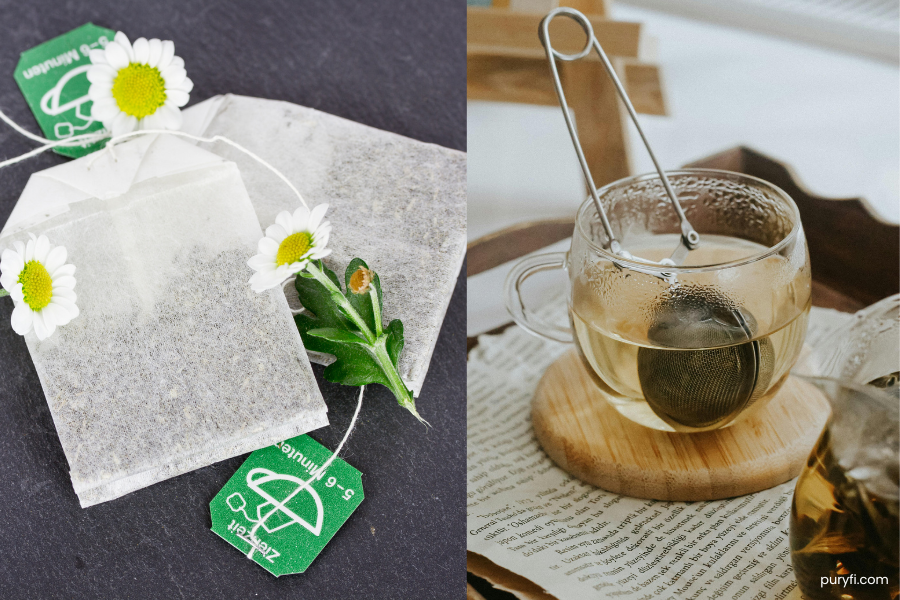
Where It’s Hidden
Your daily tea ritual might include heat-sealed tea bags with polypropylene fibers, invisibly releasing microplastics when steeped in hot water.
Why It Matters:
These plastic-sealed tea bags degrade minimally and release billions of microplastics into each cup. As part of everyday routines, this becomes a major contributor to microplastic intake, eroding progress toward a truly plastic-free lifestyle and zero-waste living.
Effects on the Body
Microplastics ingested from tea bags can enter the digestive tract, potentially accumulating in organs and triggering inflammation, oxidative stress, and immune system disruption . Chronic exposure has been linked to gut microbiome imbalances, hormone interference, and metabolic issues . Early research also shows potential links between microplastics and cardiovascular and neurological conditions .
Greener Alternative
Switch to plastic-free tea bags made from unbleached, compostable materials. Or try loose-leaf tea in a glass or stainless-steel infuser, or reusable cloth pods. These swaps align better with sustainable alternatives to plastic and help maintain both your wellness and eco-friendly lifestyle.
3. Paper Coffee Cups with Hidden Plastic Liners
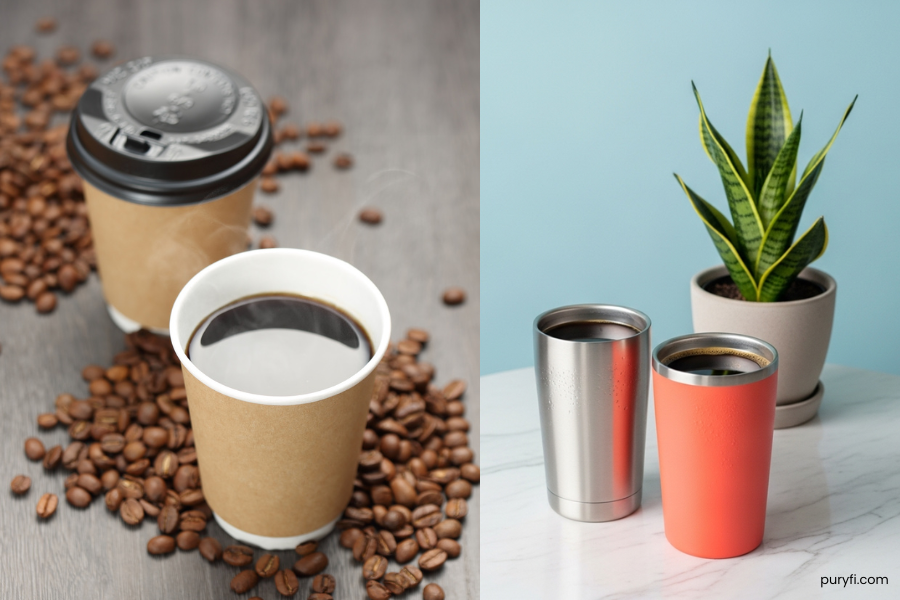
Where It’s Hidden
Takeaway coffee cups, even those labeled “paper”, often contain thin plastic linings that prevent leaks, undermining recycling and composting efforts in daily cafe runs.
Why It Matters
Plastic-lined paper cups cannot be composted or properly recycled. They contribute to billions of single-use cups ending up in landfills annually, making a mockery of zero-waste ambitions and obscuring the promise of “eco-friendly” dining.
Effects on the Body
Hot beverages in plastic-lined cups can cause microplastic particles and chemical additives to seep into your drink. BPA and phthalates found in these linings are endocrine-disrupting, associated with developmental, reproductive, and metabolic problems . Over time, these contaminants may accumulate, increasing risks of hormone-related illnesses, obesity, and cardiovascular disease .
Greener Alternative
Bring a reusable mug or tumbler made from stainless steel, bamboo fiber, or glass. Many cafés offer incentives for reusable cups. For events, opt for compostable or biodegradable cups made from plant fiber, durable, convenient, and aligned with the best plastic-free alternatives for eco-conscious hosting.
4. Food Storage Bags & Takeaway Boxes
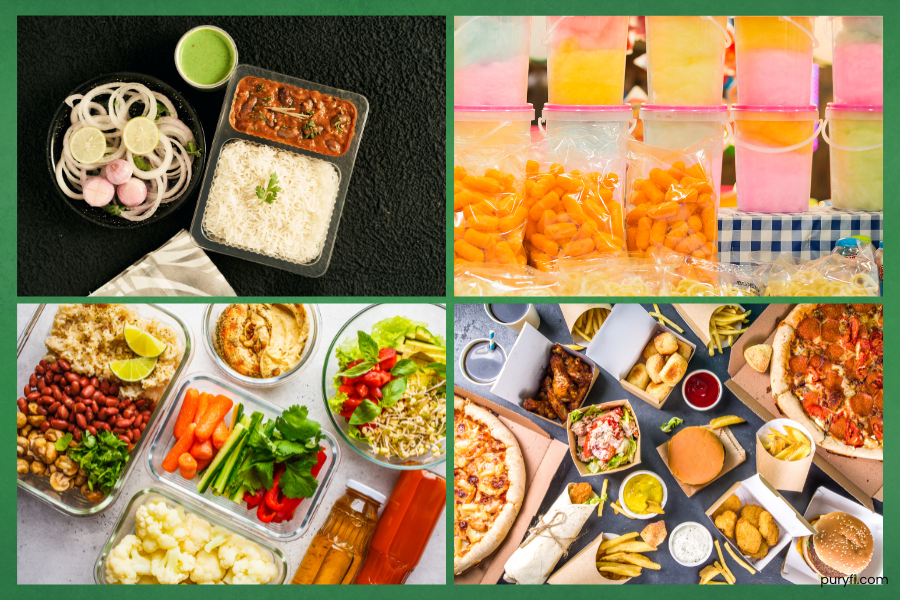
Where It’s Hidden
Your fridge likely holds frozen meals in plastic zip-lock bags or food delivery containers made of unsustainable plastic, each meal contributing to hidden single-use waste.
Why It Matters
Plastic bags and takeaway containers often contain harmful additives and degrade into microplastics, and leach chemicals when microwaved. Most aren’t recyclable or compostable, creating persistent household waste that undermines your zero-waste lifestyle goals.
Effects on the Body
Heating plastic containers leads to the leaching of phthalates and other endocrine-disruptors, linked to obesity, insulin resistance, and hormone imbalances . Microplastics from degraded plastics accumulate in organs and provoke inflammation, oxidative stress, and possible metabolic disorders . Studies have associated chronic exposure with gut dysbiosis and cardiovascular disease .
Greener Alternative
Swap to glass containers, stainless-steel tiffins, silicone storage bags, or compostable paper boxes. Beeswax wraps can replace plastic film. These plastic-free alternatives help sustain your green lifestyle, while keeping your food fresh and safe without hidden toxins.
5. Produce Stickers

Where It’s Hidden
Almost every apple, avocado, or orange from grocery stores has a small vinyl sticker—an overlooked source of single-use plastic you likely composted or tossed without thinking.
Why It Matters
These tiny produce stickers aren’t compostable and contaminate recycling and compost streams. One small sticker can contaminate whole batches. While individually minute, collectively they add up to billions of micro-sized plastic pieces entering waste systems annually, hindering county zero-waste programs and green-lifestyle goals.
Effects on the Body
While eating produce, peeling off the sticker may not seem consequential, but any residual adhesive or microplastic on the rind can transfer during cutting or peeling. Microplastics from contaminated compost can enter the soil and local produce. Research increasingly links microplastic ingestion to gut inflammation and disruption of beneficial gut bacteria, potentially contributing to digestive issues and chronic inflammation.
Greener Alternative
Choose unpackaged produce, shop at farmers’ markets, or rinse and peel stickers before composting. Some growers use laser-etched labels instead. These small changes support local growers and promote sustainable alternatives to plastic in everyday shopping.
6. Toothbrushes & Toothpaste Tubes
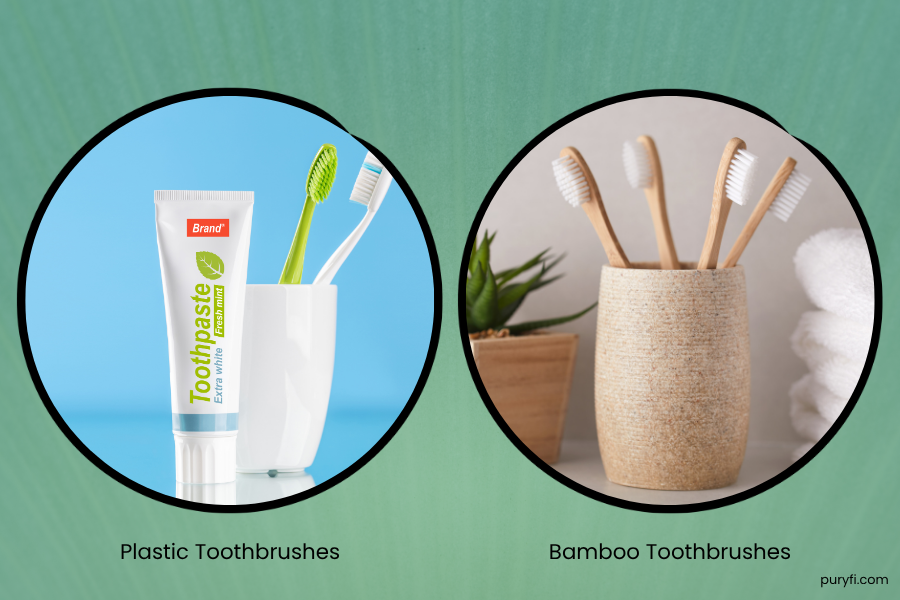
Where It’s Hidden
Your daily dental routine includes plastic toothbrushes and multilayer toothpaste tubes, items often replaced monthly and routinely tossed, likely in regular trash, not recycled.
Why It Matters
Plastic toothbrush handles and nylon bristles are non-biodegradable and persist in landfills for centuries. Toothpaste tubes are hard to recycle due to multilayer materials. These small items cumulatively contribute to U.S. plastic volume, just a small percentage of which is recycled annually.
Effects on the Body
Microplastics from degrading toothbrush bristles can enter the oral cavity or wastewater, possibly affecting gut microbes. Plastic additives like bisphenols and PEGs are linked to hormone disruption and inflammation. According to Science Direct, microplastics can potentially carry chemicals that interfere with the endocrine system and immune function.
Greener Alternative
Switch to a bamboo toothbrush with biodegradable bristles, and toothpaste tablets or powders in refillable glass or aluminum containers. These are widely available, effective, and significantly reduce plastic in your daily routine.
7. Wipes & Cotton Swabs
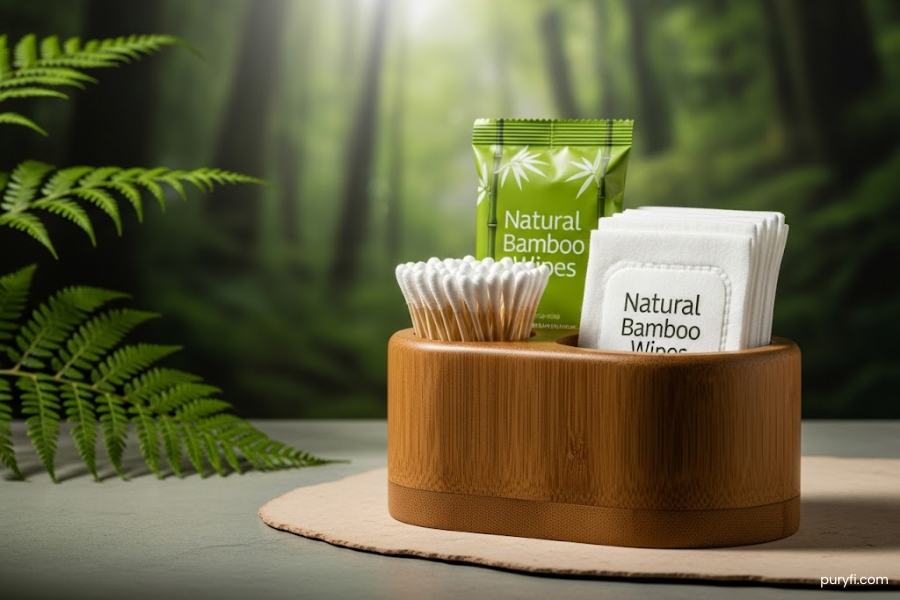
Where It’s Hidden
Your makeup bag, diaper changing station, and medicine cabinet often hold wipes and cotton swabs containing plastic fibers or stems. Dispose them in regular trash.
Why It Matters
Many wipes contain polyester or polypropylene and are labeled “flushable”. However, not all break down and they cause sewer clogs and false recycling claims. Plastic swab stems persist for decades, leaking microplastics into landfills and our waterways.
Effects on the Body
Microplastic fibers from wipes can enter water, cling to skin or facial tissue, and they get absorbed into the body. Plastic residue is linked to skin irritation, respiratory issues, and heightened risk of allergies. A Stanford Medicine study shows microplastic residues can irritate skin and potentially disrupt microbiomes in sensitive areas. Environmental exposure also increases anti-inflammatory cytokines and respiratory stress markers.
Greener Alternative
Use biodegradable wipes from bamboo or cotton, reusable cloth pads, and bamboo or paper-stemmed cotton swabs. They’re affordable, gentle, and align with a sustainable lifestyle, cutting hidden plastics in personal care with zero compromise.
8. Sunscreen & Skincare Tubes
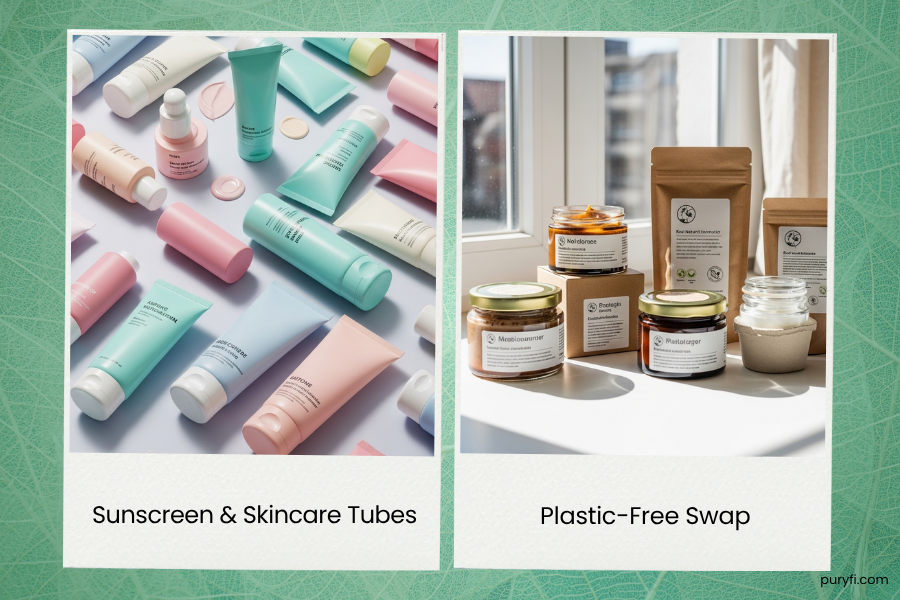
Where Plastic Hides
From moisturizers to sunscreens, most skincare products come packaged in plastic tubes, squeeze bottles, or pump containers. These containers are typically made from a mix of plastics, adhesives, and sometimes even metal springs in pumps, making them nearly impossible to recycle in municipal systems.
Why It Matters
While they may look harmless sitting on your bathroom shelf, these tubes contribute significantly to plastic pollution. According to the EPA, more than 120 billion units of cosmetic packaging are produced globally each year, most ending up in landfills or oceans. The biggest problem is that their complex materials make them non-recyclable. Even “greenwashed” products often have hidden plastics in labels, laminates, and caps. What’s more, when these products are stored in heat (like a hot car or sunny windowsill), plastics can leach into the formulas.
Effects on the Body
Many plastics used in skincare packaging or formulations can introduce endocrine-disrupting chemicals (EDCs) into your system. Studies have shown links between BPA, for instance, and hormone imbalance, infertility, early puberty, and certain cancers. A study by the National Institutes of Health (NIH) found that BPA exposure through skin contact can be significant, especially when combined with other absorption enhancers often found in lotions and sunscreens.
In addition, researches have shown that plastic microbeads penetrate skin layers, disrupt cellular activity, and enter the bloodstream, increasing oxidative stress and potential immune responses.
Plastic-Free Swap
Look for skincare and sunscreen products that come in glass jars, aluminum tins, or biodegradable packaging. Several clean beauty brands in the U.S. now offer plastic-free, reef-safe, and microbead-free options. Bonus points if they use compostable mailers or offer refill programs. Avoid anything with “polyethylene” or “polypropylene” listed in the ingredients — those are red flags for microplastics.
9. Cleaning Sponges & Brushes
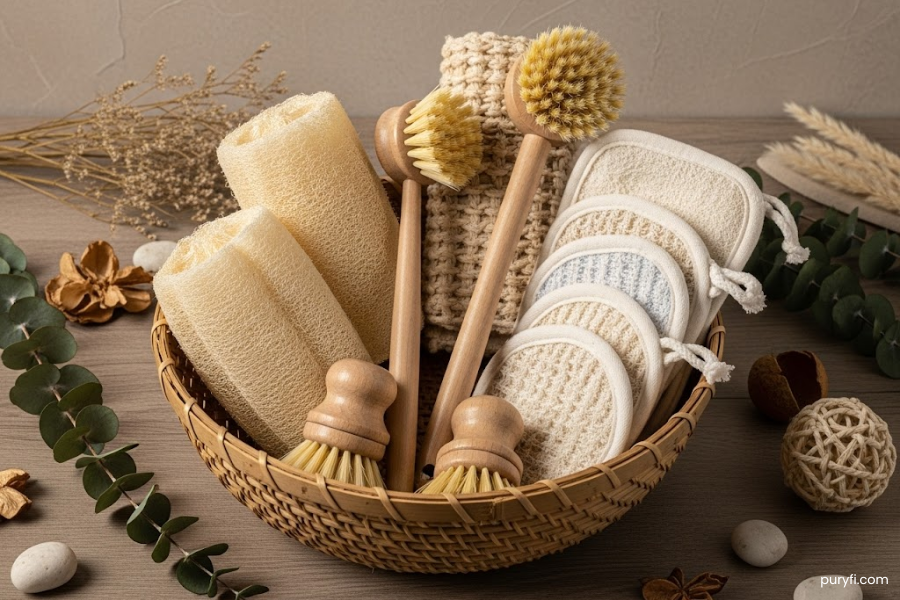
Where It’s Hidden
Your sink area likely includes synthetic sponges or scrubbers that shed particles during washing.
Why It Matters
Polyurethane sponges and synthetic brushes degrade into microplastics with use. These particles pass through sewer systems and cannot be filtered. They ultimately enter waterways and marine life, contributing to the massive microplastic pollution problem.
Effects on the Body
In household environments, inhalation of microplastic fibers can occur during scrubbing. These particles cause oxidative stress in lung cells and exacerbate respiratory inflammation in animal studies by NIH-funded research. Ingested microplastic fragments may also disrupt gut microflora, interfere with nutrient absorption, and contribute to chronic disease risk.
Greener Alternative
Replace synthetic sponges with natural loofahs, wooden dish brushes with plant-fiber bristles, or cloth scrubbers. These alternatives clean effectively without plastic shedding, supporting your zero waste lifestyle and reducing the daily microplastic load in your home.
10. Thermal Paper Grocery Receipts
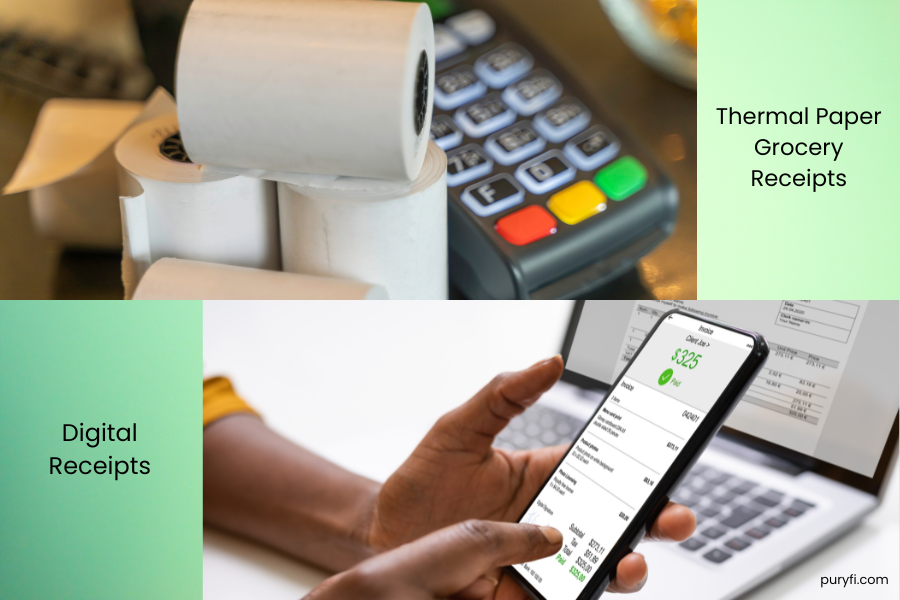
Where It’s Hidden
Most receipts today are printed on thermal paper — a slick, glossy kind often coated with BPA (Bisphenol A) or BPS (Bisphenol S). These aren’t just chemicals; they’re synthetic plastic coatings used to develop the print when heat is applied — no ink needed.
Why It Matters:
Every time you touch one of these receipts, you’re transferring BPA or BPS onto your skin. These chemicals don’t just sit there; they’re absorbed into your bloodstream within seconds. Handling receipts multiple times a day, especially without washing your hands, causes the plastics to accumulate silently over time. And if you’re eating or applying lotion after handling one? That speeds up the absorption.
Effects on the Body
Studies from the National Institute of Environmental Health Sciences show BPA absorbed through skin can mimic estrogen, linked to reproductive issues, type 2 diabetes, and obesity. Regular handling of receipts has been associated with higher urine BPA levels in cashiers. The US CDC weekly report confirms occupational BPA exposure as a public health concern.
Greener Alternative
Ask for digital receipts sent via email or app, or simply decline printed ones when not needed. These are practical steps toward planet-friendly living and eliminate a frequent source of hidden endocrine disruptors.
Bringing It All Together: Why These Swaps Make a Difference
You might wonder: Are these small changes really worth it? The answer is a resounding yes. Each swap, whether compostable tableware or bamboo brush, helps:
- Reduce landfill waste
- Lower toxic exposure in your home
- Support the market for sustainable alternatives to plastic
- Build momentum for broader cultural change
When multiplied across households and communities, these shifts add up. They shape demand for eco-products and send a message that planet-friendly living is possible, practical, and powerful.
A Community of Intentional Living
This isn’t about perfection, it’s about intention. A plastic-free lifestyle isn’t a checklist, it’s a mindset. Even small steps, swapping your plate, toothbrush, or laundry routine, sent signals. Over time, those signals evolve into habits that align with sustainable living.
One host described her experience:
“We rented palm leaf plates for our daughter’s birthday. The kids loved them. Cleanup was effortless. And composting them afterward just felt right, instead of another bag of plastic in the trash.”
Seeing that effect on your land and in your community can make sustainability feel both personal and attainable.
Awareness Is the First Step
You don’t need to feel overwhelmed. The point isn’t to eliminate all plastic immediately, but to open your eyes to where it hides and what you might do instead.
Start by replacing just one item, maybe your disposable plates or plastic coffee cups, with compostable or reusable options. Next time you browse receipts, wave the paper copy off. Question the sponge in your sink. Each conscious swap becomes part of a more sustainable daily rhythm.
Because creating planet-friendly living isn’t about perfection. It’s about progress. And every plastic-free swap you make matters, not just to you, but for our shared future.

